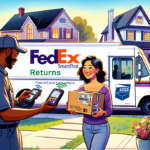Understanding USPS SmartPost Returns
USPS SmartPost is a shipping service offered by the United States Postal Service (USPS) that leverages both USPS and FedEx networks to deliver packages efficiently. This hybrid service is particularly beneficial for ecommerce businesses aiming to reduce shipping costs while maintaining reliable delivery for their customers. In this article, we delve into the intricacies of USPS SmartPost returns, exploring how the service operates, its advantages, and best practices for both retailers and customers.
How USPS SmartPost Works
Overview of USPS SmartPost
USPS SmartPost combines USPS’s extensive last-mile delivery network with FedEx’s long-haul transportation capabilities. This integration allows businesses to ship packages more economically, especially for lightweight items. By utilizing USPS for final delivery, SmartPost ensures packages reach customers efficiently while keeping costs low.
Return Process with USPS SmartPost
Using USPS SmartPost for returns involves several steps:
- Authorization: Customers initiate the return process by obtaining authorization from the retailer.
- Shipping Label: A USPS SmartPost shipping label is generated, containing a unique barcode for tracking.
- Packaging: The customer packages the item securely and attaches the shipping label.
- Drop-off: The package is dropped off at the nearest USPS location.
- Processing: USPS handles the transportation and delivery of the return to the retailer’s address.
This streamlined process ensures that returns are handled efficiently, benefiting both retailers and customers.
Benefits of Using USPS SmartPost for Returns
Cost-Effectiveness
One of the primary advantages of USPS SmartPost is its affordability. According to [USPS Rate Comparison](https://www.usps.com/business/pricing/), SmartPost rates are typically lower than standard shipping options, making it a cost-effective choice for businesses managing high return volumes.
Convenience for Customers
SmartPost simplifies the return process by providing customers with printable shipping labels and multiple drop-off locations. This eliminates the need for customers to visit physical store locations, enhancing their overall shopping experience.
Reliable Tracking and Confirmation
USPS SmartPost offers comprehensive tracking capabilities, allowing both retailers and customers to monitor the status of returns in real-time. Delivery confirmation ensures that retailers have proof of return receipt, reducing disputes related to undelivered packages.
Environmental Sustainability
By optimizing transportation networks, USPS SmartPost contributes to a reduced carbon footprint. According to the [Environmental Protection Agency](https://www.epa.gov/greenvehicles/greenhouse-gas-emissions-typical-passenger-vehicle), efficient logistics can significantly lower greenhouse gas emissions associated with shipping.
Initiating a Return with USPS SmartPost
Step-by-Step Guide
To initiate a return using USPS SmartPost, customers should follow these steps:
- Request Authorization: Contact the retailer to obtain return approval.
- Print Shipping Label: Access the retailer’s website to print the USPS SmartPost label.
- Prepare Package: Securely pack the item and affix the shipping label.
- Drop Off Package: Take the package to the nearest USPS location for drop-off.
Ensuring each step is followed accurately can prevent delays and ensure a smooth return process.
Tracking and Managing Returns
Real-Time Tracking
USPS SmartPost provides real-time tracking through the USPS website and the retailer’s return portal. Customers can enter the unique barcode from their shipping label to monitor their return’s journey from drop-off to receipt by the retailer.
According to [USPS Tracking](https://tools.usps.com/go/TrackConfirmAction_input), detailed tracking information is available, enhancing transparency and trust between retailers and customers.
Managing Return Data
Retailers can utilize the tracking data to manage their return processes more effectively. By analyzing return trends, businesses can identify common issues and improve their product offerings or return policies accordingly.
Common Issues and Solutions with USPS SmartPost Returns
Lost or Delayed Packages
Despite its reliability, some packages may get lost or delayed. To mitigate this, customers should ensure packages are properly labeled and securely packed. Retailers should provide clear return instructions and encourage customers to drop off packages promptly.
Inaccurate Shipping Information
Incorrect shipping information can lead to delivery failures. Verifying the accuracy of the shipping label before dropping off the package is crucial. Retailers should implement validation checks on their return portals to minimize errors.
Comparing USPS SmartPost with Other Return Shipping Methods
USPS SmartPost vs. UPS and FedEx
When compared to UPS and FedEx, USPS SmartPost often offers more competitive pricing, especially for lightweight and bulk returns. However, services like UPS and FedEx may provide faster delivery times and more robust customer service options.
According to a [FedEx vs. USPS](https://www.fedex.com/en-us/shipping/international/shipping.html) comparison by industry analysts, SmartPost is ideal for cost-sensitive returns, while UPS and FedEx are better suited for time-sensitive shipments.
USPS Priority Mail Comparison
USPS Priority Mail offers faster delivery times compared to SmartPost but at a higher cost. Businesses must balance the need for speed against budget constraints when choosing the appropriate return shipping method.
Strategies to Save Money on Return Shipping with USPS SmartPost
Optimize Packaging
Using appropriately sized boxes can prevent unnecessary weight and dimensional charges. Businesses should guide customers on optimal packaging practices to keep return costs low.
Encourage Bulk Returns
Encouraging customers to consolidate multiple returns into a single shipment can reduce overall shipping expenses and operational costs.
Leverage Volume Discounts
Retailers with high return volumes can negotiate volume discounts with USPS, further reducing per-package shipping costs. It's advisable to contact USPS directly or work with a shipping partner to explore available discounts.
Best Practices for a Successful USPS SmartPost Return Experience
Clear Communication
Retailers should clearly communicate their return policies and provide detailed instructions to customers. This includes information on how to print shipping labels, packaging guidelines, and drop-off locations.
Efficient Processing
Promptly processing returned items once received can enhance customer satisfaction and streamline inventory management. Implementing automated systems to track and manage returns can improve efficiency.
Customer Support
Providing accessible customer support for return-related inquiries can help address issues quickly and maintain customer trust.
Troubleshooting Lost or Delayed Returns with USPS SmartPost
Immediate Actions
If a return is lost or delayed, customers should:
- Contact the retailer to report the issue.
- Provide the tracking number for investigation.
Retailers should follow up with USPS to track the package and resolve any issues, potentially filing a claim if necessary.
Contacting USPS
Customers can reach out to USPS customer service via the [USPS Contact Page](https://www.usps.com/help/contact-us.htm) to inquire about the status of their return and initiate any required claims process.
The Role of Retailers in the USPS SmartPost Returns Process
Authorizing Returns
Retailers must establish clear return authorization procedures to ensure that only eligible items are returned. This involves verifying purchase details and return eligibility based on the retailer’s policies.
Providing Shipping Labels
Supplying accurate and easy-to-use shipping labels is essential. Retailers should integrate label generation into their online platforms, allowing customers to print labels without hassle.
Processing Returns Efficiently
Upon receiving returned items, retailers should inspect and process them promptly. Efficient processing helps in restocking inventory and providing timely refunds or exchanges to customers.
Frequently Asked Questions About USPS SmartPost Returns
What products can be returned with USPS SmartPost?
Answer: Customers can return any products eligible under the retailer’s return policy using USPS SmartPost. It’s best to check specific return guidelines provided by the retailer.
How long does it take for a return to be processed using USPS SmartPost?
Answer: Returns typically take 5-10 business days to be processed after receipt by the retailer. Processing times may vary based on the retailer’s internal procedures and the volume of returns.
Does USPS SmartPost provide insurance for returned packages?
Answer: No, USPS SmartPost does not include insurance by default. Customers and retailers can purchase additional insurance coverage separately if needed.
Can I use USPS SmartPost for international returns?
Answer: No, USPS SmartPost is designed for domestic returns within the United States only. For international returns, other shipping methods like USPS Priority Mail International or services offered by carriers such as FedEx and UPS should be considered.
Conclusion
USPS SmartPost stands out as a reliable and cost-effective solution for managing returns in the ecommerce landscape. By leveraging both USPS and FedEx networks, it offers businesses a way to handle returns efficiently while keeping costs low. For customers, the convenience of printable labels and accessible drop-off locations enhances the overall shopping experience. By following best practices and addressing common challenges proactively, retailers can maximize the benefits of USPS SmartPost, ensuring a smooth and hassle-free return process for all parties involved.




















